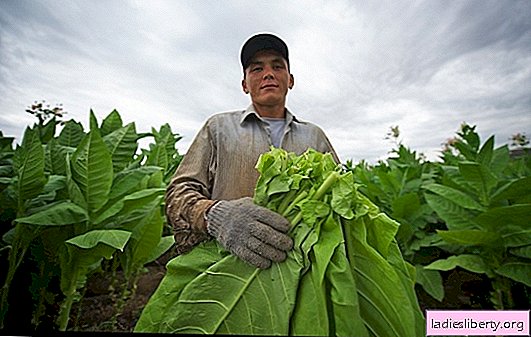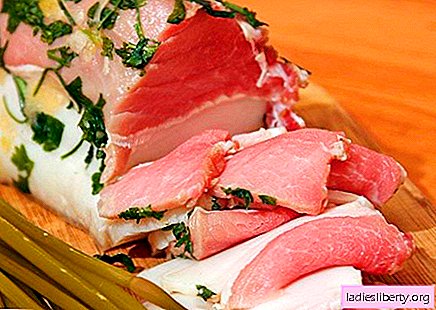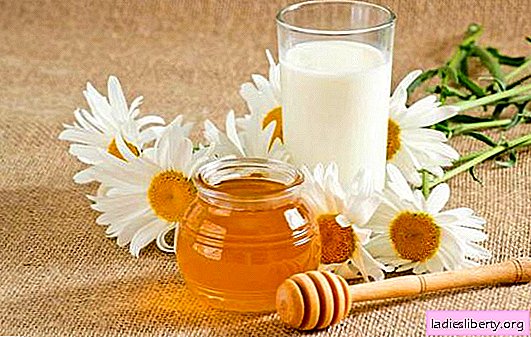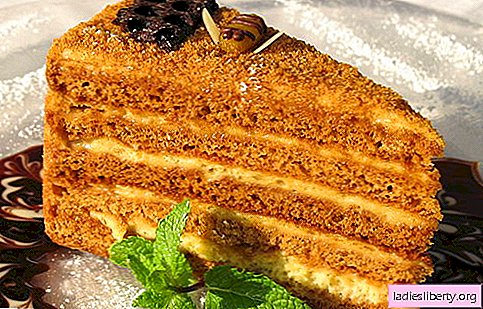
Experienced gardeners claim that growing tobacco is no more difficult than tomatoes.
The plant is thermophilic and well amenable to cultivation in the south country. But it is successfully cultivated even in cold regions.
Germination and final taste characteristics of tobacco will depend not only on the selected variety, but also on the soil condition on the site and the abundance of the sun.
Think tobacco is grown only by heavy smokers? No, this culture blooms beautifully than it decorates any plot, and can become a means to combat some of the diseases and pests common in the garden.
What kind of tobacco to choose for growing?
There are many varieties of tobacco. But not all of them are suitable for home cultivation. If you are a beginner in this business, choose those plant species that are adapted to our climatic conditions - leave “exotic” varieties for professionals, plant them with entire plantations for the further sale of tobacco leaves.
In the world tobacco growing plant is divided into 2 types - cigar and cigarette. In our country it is easier to cultivate varieties of cigarette-like. We list the most popular varieties of tobacco that experienced gardeners choose to cultivate in summer cottages or at home:
• Trapezond 92. Resistant to viral diseases grade. It is famous for its short growing season - you can harvest in 100 days after planting.
• Ducat Crimean. This is a large plant with fragrant leaves up to 1 m in length. Ripens quickly.
• Trapezond Kubanets. Grows in 105-135 days. The variety is characterized by an average yield of about 25 technically suitable for the processing of tobacco leaves.
• Virginia 202. Rennedy grade, perfectly gaining strength and aroma. Resistant to diseases and withstand negative environmental conditions. As part of the leaves a lot of carbohydrates.
• Samsun 85. Mid-season variety, reaching maturity for 105-110 days after planting on the site. Up to 50 leaves can be collected from one bush - a high-yielding type of plant.
• Holly 316. In a plant, in comparison with its other varieties, a small amount of nicotine is contained. Ripens late - up to 120 days.
• Dubeck. The variety comes from Turkey. Named the best aromatic tobacco in the world. In the middle zone, it will not show large yields - suitable only for cultivation in hot climates.
• Country tobacco. Frost-resistant and unpretentious. Suitable for growing not only in the open area, but also on the windowsill or balcony.
• Jubilee new 142. Quick ripening variety - the crop can be harvested 80 days after planting. Resistant to many diseases.
Buy tobacco seeds from reliable vendors. It is unlikely that it will be possible to find them on free sale on the store shelves - look in online stores or from private traders who cultivate plants. The cost of seeds, depending on the selected variety, ranges from 30-100 rubles. for 50 pcs. And in the future to buy seeds and do not need - 2-3 bush plants will give so many seeds that they can sow hectares of land.
Choosing a place for planting tobacco
Tobacco, if it is provided with optimal conditions for development, can take root in any conditions. The best soil for the plant is a light, loose, pebble-rubble structure, with a high content of humus. In marshy, too wet areas, tobacco will not grow. Culture loves the sun, and therefore, pick up under planting unbroken areas of the garden. Here cold winds should not blow - for seedlings they will be disastrous.
When choosing a place for growing tobacco, consider the crop rotation. It has been established that the best plant predecessors are legumes, cereals, winter breads, beets, perennial grasses. But after the nightshade and sunflower tobacco, it is not recommended to plant tobacco at the same place, since these plants have similar diseases - there is a risk of infecting young plants.
Sowing and planting tobacco
Just starting to grow tobacco? Then start with the cultivation of several bushes, and not the whole beds - test your strength and check how well the selected plant variety lives in these climatic conditions.
Tobacco loves heat, so you can never wait for the crop when sowing seeds immediately in open ground, because they will not hatch in the cold ground. The best way - plant a seedling plant.
Seed material is very small, which makes it difficult to work with it. And in spite of the fact that it is simpler to plant dry seeds, it is better to prepare them in advance to achieve quick shoots. To do this, 3-5 days before the intended landing on the seedlings soak the seeds, wrapped in a soft rag, in warm clean water. You can add a couple of drops of tartaric acid or a few crystals of potassium nitrate. In this form, leave the seed for a day. Then rinse the seeds, drain the excess water and leave in a warm place for germination in a pottery or enamelled container (also - in a rag). Moisten the cloth periodically. After 2-4 days, the seeds hatch. We can not allow the formation of a sprout longer than a seed! When most of the seeds turn out, they must be thoroughly dried, mixed with sand or humus. In this state, if it is not possible to start planting “right now”, the material can be stored until planting for several more days.

Start cooking seedlings for growing tobacco in February-March. By the beginning of the season, young seedlings are already quite strong for a transfer to a "permanent place of residence." The scheme of sowing tobacco on seedlings is as follows:
• Fill the pot or seedling box with nutrient soil.
• Water the soil before sowing.
• Depth of seeding is no more than 0.8 cm.
• Sprinkle seeds with a mixture of humus and sand (3: 1).
• Water the soil (waterlogging is not allowed).
The optimum temperature required for germination is + 25 ... +28 ˚C. Keep a container of seedlings can be on the windowsill or balcony. When the first shoots appear above the ground, it is better to reduce the temperature to +20 ° C. Planting should be watered regularly. Do this carefully so that the seeds do not go deep into the ground. 2-3 times feed the plant mineral fertilizers (for example, nitrate, diluted in water).

Pick up in the stage of 3-4 full leaflets on the stalk. The seedling will be ready for planting on an open ground after 40-45 days. A week before the deadline, begin to harden the young seedlings so that they gain strength and prepare for life under the open sky. For a couple of days, stop watering the plants.
Seedlings transfer to the open area in May - when the threat of late spring frost is completely bypassed. Do it like this:
• Make holes up to 30 cm deep in the prepared grooves. Distance between plants - 20 cm, and between rows - 70 cm.
• Pour 0.5-1 liters of water into each well.
• Place the seedling with a lump of “native” land into the hole.
• Sprinkle roots with damp earth, tamp down a little.
• Place dry soil on top.
Now, in order to get high yields of fragrant leaves at the end of the season, tobacco needs to be provided with proper care.
Cultivation and care of tobacco
The best temperature for the growth and development of tobacco is 18-24 ° C. Some varieties of plants tolerate calm and cold conditions - up to +2 ° C. Favorable soil moisture - 60-70%. With low light, seedlings will develop poorly. Similar conditions can be provided in many regions of our country, which is why gardeners take up the cultivation of tobacco.
Your expectations for growing tobacco may not be justified. But the reason for poor germination and yield is not always covered in the selected variety and quality of seeds. The condition of the soil, the length of the day, the humidity and the temperature of the air - everything is important when growing tobacco! How does a plant gain its final characteristics?
• The color, size and texture of the leaves depends on the composition of the soil.
• The fragrance of the leaves depends on the humidity of the air and the soil.
• The leaves are saturated with a special taste due to free air circulation.
We list the basic rules of care for planting in the cultivation of tobacco:
• Watering. Adhere to the rule "it is better to underfill than to pour." Experienced gardeners cost 2-3 irrigations per season, while spending at the same time 5-8 liters of water per 1 bush. When the plant grows enough, you can stop it at all.
• Loosening. During the period of active growth, tobacco needs regular loosening and removal of weeds, otherwise planting will overgrow.
• Top dressing. Proper fertilization shows excellent results. For good yields, it is important to observe the optimal ratio of nitrogen, phosphorus and potassium in the feeds used. Immediately after planting, the seedlings can be fertilized with slurry with superformat. A solution of sulfur in water is also effective. After the appearance of inflorescences, many gardeners process tobacco with infusion of garlic and onion peel.
• Rushing Removing inflorescences and upper leaves helps to increase the yield of tobacco, since nutrients will not be spent on flowering, but will go to the development of valuable leaves.
Pest and Disease Control
The smell of growing tobacco scares off some pests. But there are still "instances" that the plant attracts. Care for the bushes, mainly, will be to combat diseases and pests.
We list the diseases that are dangerous to tobacco and harm:
• Peach aphid. A common type of insect that feeds on both wild and cultural types of tobacco. Aphid sucks the juice from the leaves and stems of the plant, thereby deteriorating the final properties of the raw materials and reducing the yield. You can recognize aphids by the sticky secretions that it leaves after their "meals". Having seen the first signs of the pest, it is possible to treat the plantings with a solution of methation or rogor.
• Tobacco thrips. This pest eats not only tobacco, but also other cultivated plants. Insects eat leaves, reducing yields and suffering dangerous diseases. To avoid pest infestation, no later than a month before planting, treat the soil with 12% hexachlorane dust. Three times per season, sprinkle with a diluted suspension of methation or rogor.
• Black root rot. A disease that often affects seedlings, but adult plants can also become infected. Tobacco leaves wither and dry, and the roots die in the advanced stages of the lesion. From the rot will help watering the soil with benat. The drug is used for prophylaxis when tilling the soil immediately after planting, and when the first signs of infection appear.
• Blackleg. The disease can completely destroy the seedlings - the affected base of the stem becomes thin and gradually dies off. The bad thing is that the causative agent of the disease remains in the soil - the next “batch” of plantings is also infected. The black leg is more pronounced in high humidity and in the ground with excess nitrogen. For the prevention of black legs, you can try to spray the seedlings with a 0.3% suspension of 80% zineb.
• Mealy dew. Bacterial disease, manifested by the appearance on the leaves of a whitish powdery plaque. Tobacco leaves turn brown and with further drying lose their flavor. Powdery mildew can be disposed of with a 1% suspension of colloidal sulfur.
• Mosaic. A pathogenic virus that changes the color of tobacco leaves - light green blotches appear. Later, the infected areas of the leaves die off. The source of infection is plant residues that have not been harvested from the site before planting. Effective remedy against all types of mosaic - 80% polycarbacin.
• Bacterial Fritillary. The disease is accompanied by the appearance of oily or oozing spots on the leaves, which leads to rotting of the plants. It is very difficult to get rid of the causative agent of the virus, since it can persist for some time even on the garden inventory. The summer residents are helped by spraying the plants with 0.5% Bordeaux liquid. But it is better to prevent the disease, observing crop rotation.
Since pathogens can remain in the soil and on the inventory, when detecting "contagion" it is recommended to process all working tools and, if possible, nearby areas of soil. Inventory is well cleaned with 40% formalin. It should then be kept for 3-4 days under a tarp at a temperature not lower than 10 ° C.
Tobacco Harvest
Already in August, you can start collecting tobacco. Some varieties of plants need to be kept in the ground a little longer - until the end of September. Lower leaves of tobacco gently break off and keep in the sun for 2 days. After that, the raw materials must be dried for a couple of months in a dark, wet room - the basement will do.

The process of preparing tobacco leaves for use is complicated. To get fragrant cigar leaves at the exit, their fermentation is necessary - extract of the raw materials in certain conditions. Depending on the variety selected, the process varies in temperature and humidity. Tobacco, obtained at home, will necessarily differ in properties from the products purchased in the store.











